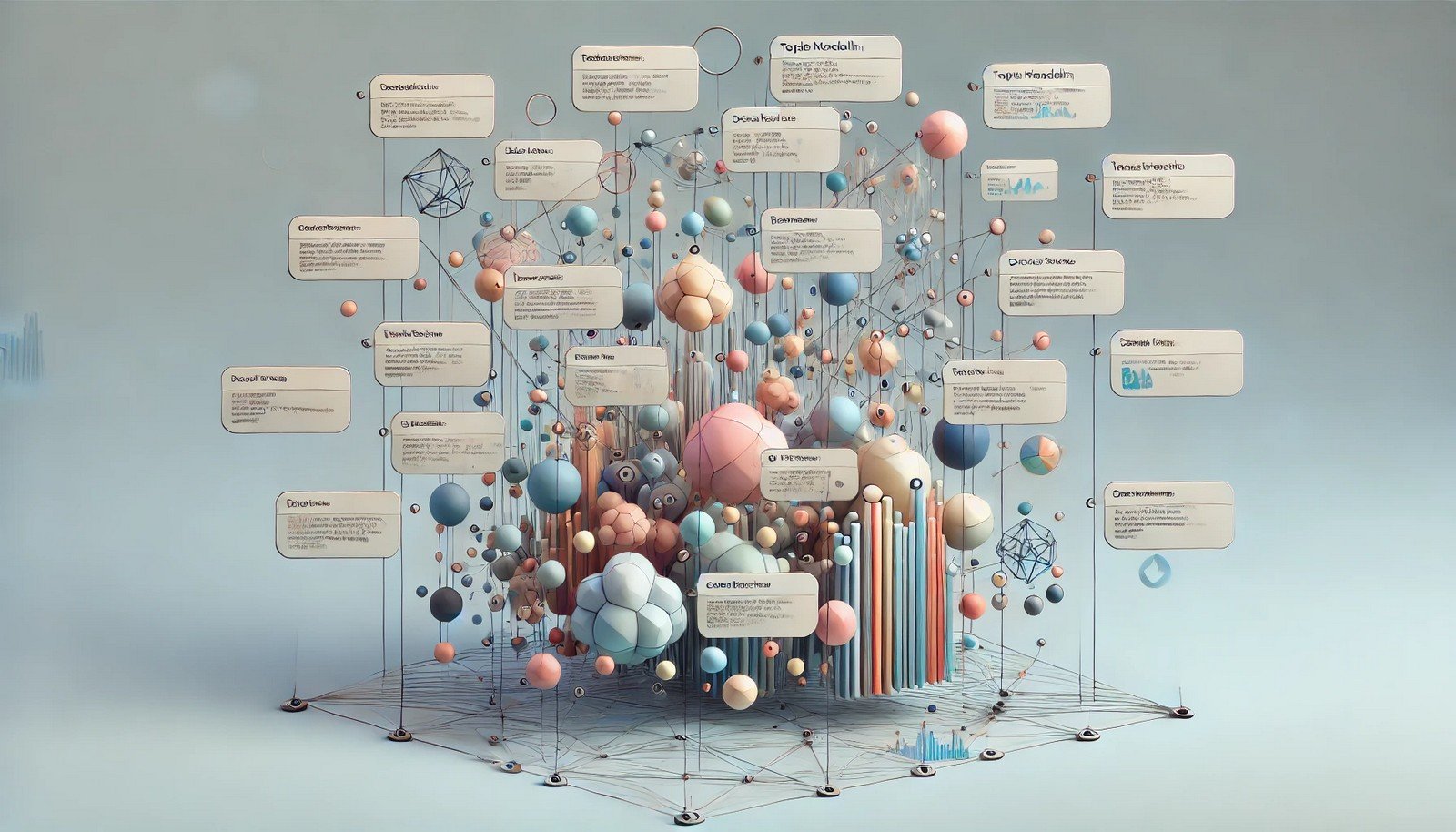Topic Modeling

Quick Navigation:
- Topic Modeling Definition
- Topic Modeling Explained Easy
- Topic Modeling Origin
- Topic Modeling Etymology
- Topic Modeling Usage Trends
- Topic Modeling Usage
- Topic Modeling Examples in Context
- Topic Modeling FAQ
- Topic Modeling Related Words
Topic Modeling Definition
Topic Modeling is a technique in natural language processing (NLP) used to discover hidden thematic structures in large bodies of text. Through unsupervised learning, algorithms identify recurring themes (topics) within documents, clustering words with similar meanings or associations. The most popular algorithms include Latent Dirichlet Allocation (LDA) and Non-negative Matrix Factorization (NMF), which classify topics based on probability distributions. This method is invaluable in processing and understanding extensive text corpora, as seen in customer feedback analysis, research literature, and social media content.
Topic Modeling Explained Easy
Imagine a huge library with lots of books, each about different topics like animals, planets, or history. Topic modeling is like a tool that reads these books and tells us what each one is mostly about, without needing a teacher to tell it. So if it finds words like "planet" and "space" often together, it guesses the topic is about space!
Topic Modeling Origin
The concept of Topic Modeling evolved in the early 2000s from advancements in statistical machine learning, driven by a need to organize and understand vast text collections. Initially developed for academic literature analysis, it quickly expanded to various domains as digital data volumes surged.
Topic Modeling Etymology
The term "Topic Modeling" stems from the focus on "topics" or themes and the “modeling” process to estimate them through statistical approaches.
Topic Modeling Usage Trends
Topic Modeling has gained traction across many fields, from social media analysis and marketing to legal document review and academic research. Its popularity has grown with advances in computational power, making it easier to process vast amounts of unstructured text and identify patterns that inform decision-making.
Topic Modeling Usage
- Formal/Technical Tagging:
- Unsupervised Learning
- Natural Language Processing
- Text Mining - Typical Collocations:
- "topic modeling algorithm"
- "LDA topic model"
- "discovering latent topics"
- "unsupervised text analysis"
Topic Modeling Examples in Context
- Topic modeling helps researchers analyze large volumes of scientific papers, grouping them by research themes like genetics, ecology, or climate change.
- Customer feedback in e-commerce can be analyzed with topic modeling to identify themes in reviews, like quality, shipping speed, or customer service.
- Social media platforms use topic modeling to track trending topics, allowing them to understand user interests and respond to content preferences.
Topic Modeling FAQ
- What is topic modeling?
Topic modeling is a machine learning technique that identifies themes in text data without labels. - What is the most common algorithm used in topic modeling?
Latent Dirichlet Allocation (LDA) is widely used for identifying topics in unstructured text. - How does topic modeling differ from text classification?
Unlike text classification, which requires labeled data, topic modeling is unsupervised and finds topics without predefined categories. - Where is topic modeling used?
It’s used in fields like marketing, journalism, academia, and social media to analyze text data. - Is topic modeling always accurate?
Accuracy can vary depending on data quality and preprocessing, but it provides a good approximation of themes. - Can topic modeling be applied in real-time?
Yes, with sufficient computational resources, it can process data in real-time, especially for social media. - What challenges does topic modeling face?
Challenges include selecting the number of topics and ensuring topics are meaningful and interpretable. - How is topic modeling applied in e-commerce?
It identifies themes in customer feedback, helping businesses understand product issues or improvement areas. - What is Latent Dirichlet Allocation?
LDA is an algorithm for discovering hidden topic structures in text data by treating documents as mixtures of topics. - Can topic modeling be integrated with other AI methods?
Yes, it’s often combined with sentiment analysis or clustering techniques for deeper insights.
Topic Modeling Related Words
- Categories/Topics:
- Unsupervised Learning
- NLP
- Data Science
Did you know?
Topic modeling was first popularized by Google researchers in the early 2000s to improve the relevance of search results by clustering similar web pages based on common themes. This innovation significantly enhanced the efficiency of search engines and information retrieval systems.
PicDictionary.com is an online dictionary in pictures. If you have questions or suggestions, please reach out to us on WhatsApp or Twitter.Authors | Arjun Vishnu | @ArjunAndVishnu

I am Vishnu. I like AI, Linux, Single Board Computers, and Cloud Computing. I create the web & video content, and I also write for popular websites.
My younger brother, Arjun handles image & video editing. Together, we run a YouTube Channel that's focused on reviewing gadgets and explaining technology.



Comments powered by CComment